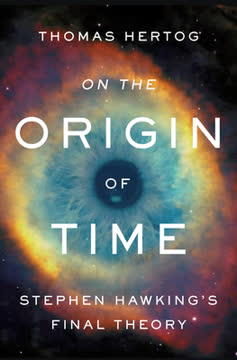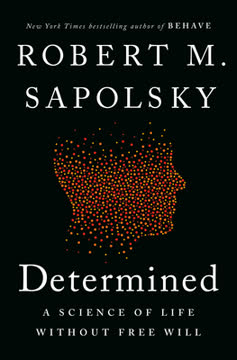Key Takeaways
1. Life's origin: From primordial soup to alkaline vents
It's as if they were waiting to be bidden into existence.
From soup to vents. The origin of life has long puzzled scientists, with the "primordial soup" theory dominating for decades. However, recent evidence points to deep-sea alkaline hydrothermal vents as a more likely birthplace of life. These vents provide:
- Concentrated organic molecules
- Energy gradients
- Natural electrochemical reactors
- Porous structures for protocells
Chemical evolution. In these vents, simple molecules could have combined to form more complex ones, eventually leading to self-replicating systems. The key steps in this process likely included:
- Formation of RNA-like molecules
- Development of primitive metabolic cycles
- Emergence of lipid membranes
- Evolution of protein synthesis
2. DNA: The universal code of life
Suddenly the origin of life looked easy.
The double helix. DNA's structure, discovered by Watson and Crick in 1953, revolutionized our understanding of life. Its double-helical structure allows for:
- Faithful replication
- Storage of genetic information
- Transmission of traits to offspring
The genetic code. The DNA code is nearly universal across all life forms, suggesting a common origin. Key features include:
- Four-letter alphabet (A, T, G, C)
- Three-letter codons specifying amino acids
- Redundancy in the code, providing robustness
- Ability to evolve and adapt through mutations
The universality of the genetic code provides strong evidence for the common ancestry of all life on Earth.
3. Photosynthesis: Harnessing the sun's power
Nature, red in tooth and claw
Solar-powered life. Photosynthesis, the process by which plants and some bacteria convert sunlight into chemical energy, transformed Earth's atmosphere and paved the way for complex life. Key aspects include:
- Splitting of water molecules to produce oxygen
- Fixation of carbon dioxide into organic compounds
- Evolution of specialized light-capturing pigments (e.g., chlorophyll)
Oxygen revolution. The oxygen produced by photosynthetic organisms dramatically changed Earth's environment:
- Oxygenation of the atmosphere
- Formation of the ozone layer
- Enabling the evolution of aerobic respiration
- Setting the stage for the evolution of complex multicellular life
4. The complex cell: A fateful union
If there ever were eukaryotes lacking the ability to move around, exerting forces with a dynamic cytoskeleton and motor proteins, then they are no longer to be found: they died out many aeons ago, along with all their progeny.
Symbiotic revolution. The eukaryotic cell, with its complex internal structures, likely arose from a symbiotic relationship between simpler prokaryotic cells. This "endosymbiotic theory" proposes that:
- Mitochondria evolved from engulfed bacteria
- Chloroplasts in plants originated from cyanobacteria
- The nucleus may have evolved to protect genetic material
Cellular complexity. Eukaryotic cells possess several features that distinguish them from prokaryotes:
- Membrane-bound organelles
- Linear chromosomes
- Sexual reproduction
- Ability to form multicellular organisms
These innovations allowed for the evolution of diverse and complex life forms, including plants, animals, and fungi.
5. Sex: Nature's genetic lottery
Sex is the most peculiar randomiser of successful genes known.
Genetic recombination. Sexual reproduction, despite its costs, provides significant evolutionary advantages:
- Increased genetic diversity
- Faster adaptation to environmental changes
- Protection against harmful mutations
Evolutionary puzzle. The prevalence of sex in nature is surprising given its apparent disadvantages:
- Two-fold cost of sex (only half of genes passed on)
- Time and energy spent finding mates
- Risk of sexually transmitted diseases
Yet, the benefits of genetic recombination seem to outweigh these costs in most cases, leading to the dominance of sexual reproduction in complex organisms.
6. Movement: The power that shaped ecosystems
Motility has indeed transformed life on earth in ways that are not immediately apparent, from the complexity of ecosystems to the pace and direction of evolution among plants.
Evolutionary driver. The ability to move actively has profoundly impacted the evolution of life:
- Enabled new feeding strategies (e.g., predation)
- Allowed colonization of new habitats
- Increased complexity of ecosystems
- Accelerated evolutionary arms races
Muscular innovation. The evolution of muscles, powered by molecular motors like myosin and actin, enabled:
- Efficient locomotion
- Manipulation of the environment
- Complex behaviors and interactions
- Development of specialized organs (e.g., hearts)
Movement has been a key factor in shaping the diversity and complexity of life on Earth, from microscopic organisms to large animals.
7. Sight: The evolutionary game-changer
95 per cent of all animal species have eyes: the handful of phyla that did invent eyes utterly dominates animal life today.
Visual revolution. The evolution of eyes has been a major driver of animal diversity and complexity:
- Enabled more sophisticated predator-prey interactions
- Allowed for complex behaviors and communication
- Drove the evolution of camouflage and warning coloration
From simple to complex. Eyes have evolved multiple times independently, but all share common principles:
- Light-sensitive proteins (opsins)
- Focusing mechanisms (lenses, pinholes)
- Neural processing of visual information
The development of eyes may have been a key factor in the Cambrian explosion, leading to a rapid diversification of animal forms and behaviors.
8. Hot blood: Breaking energy barriers
Mammals are the original eco-hooligans.
Metabolic innovation. The evolution of endothermy (warm-bloodedness) in mammals and birds provided several advantages:
- Constant body temperature independent of environment
- Increased stamina and activity levels
- Ability to inhabit a wider range of environments
Energetic trade-offs. Maintaining a high body temperature comes with costs:
- Increased energy requirements
- Need for frequent feeding
- Potential for overheating
Despite these costs, endothermy has proven to be a successful strategy, enabling mammals and birds to dominate many ecological niches.
9. Consciousness: The roots of the human mind
Feelings feel real because they have real meaning, meaning that has been acquired in the crucible of selection, meaning that comes from real life, real death.
Evolutionary perspective. Consciousness, often seen as uniquely human, likely has deep evolutionary roots:
- Primordial emotions (e.g., hunger, fear) in simple animals
- Gradual development of self-awareness
- Emergence of complex cognitive abilities
Neural basis. Modern neuroscience is uncovering the physical underpinnings of consciousness:
- Specific brain regions associated with conscious experiences
- Importance of neural synchronization and integration
- Role of emotions and feelings in shaping conscious experience
While the "hard problem" of consciousness remains unsolved, evolutionary and neurobiological approaches are providing new insights into the nature of subjective experience.
10. Death: The price of immortality
Death evolved. Ageing evolved. They evolved for pragmatic reasons.
Evolutionary necessity. Death and aging are not simply flaws in living systems but evolved traits with important functions:
- Allowing for generational turnover
- Enabling faster adaptation to changing environments
- Balancing resource allocation between reproduction and maintenance
Cellular mechanisms. The biology of aging involves several key processes:
- Accumulation of cellular damage
- Telomere shortening
- Mitochondrial dysfunction
- Epigenetic changes
Understanding these mechanisms may lead to interventions that can extend healthspan, if not lifespan, potentially alleviating many age-related diseases simultaneously.
Last updated:
FAQ
What's Life Ascending: The Ten Great Inventions of Evolution about?
- Exploration of Evolutionary Innovations: The book by Nick Lane explores ten significant evolutionary inventions that have shaped life on Earth, such as DNA, photosynthesis, and consciousness.
- Interconnectedness of Life: It emphasizes how these inventions are interconnected, contributing to the complexity and diversity of life, illustrating the intricate web of biological evolution.
- Scientific Storytelling: Lane combines scientific research with engaging narratives, making complex biological concepts accessible to a general audience.
Why should I read Life Ascending by Nick Lane?
- Insightful Perspective on Evolution: The book offers a fresh perspective by focusing on key innovations rather than a linear progression, helping readers understand the significance of each invention.
- Engaging Writing Style: Nick Lane's writing is described as witty and elegant, making complex scientific ideas enjoyable to read and captivating for both science enthusiasts and casual readers.
- Broad Scientific Scope: It spans various scientific disciplines, providing a comprehensive understanding of life's evolution and enriching the reader's knowledge and appreciation of the subject.
What are the key takeaways of Life Ascending?
- Ten Great Inventions: The book identifies ten pivotal inventions of evolution, such as DNA and photosynthesis, that transformed life on Earth and contributed to its complexity.
- Role of Natural Selection: Lane emphasizes natural selection's role in shaping these inventions, highlighting evolution as a process driven by random mutations and environmental pressures.
- Interplay of Chance and Necessity: The narrative illustrates the interplay between chance events and necessary adaptations, underscoring the unpredictability of evolutionary processes.
What are the best quotes from Life Ascending and what do they mean?
- “Life itself transformed our planet...”: This quote emphasizes the transformative power of life on Earth, highlighting how biological processes have shaped the planet's environment.
- “Evolution has no foresight...”: Lane highlights the randomness of evolutionary processes, reminding readers that adaptations arise from chance mutations rather than a predetermined plan.
- “The story that unfurls is more dramatic...”: This reflects Lane's view that the scientific narrative of evolution is rich and complex, offering a profound understanding of life's origins.
What is the significance of the origin of life discussed in Life Ascending?
- Foundation of Biological Complexity: The origin of life is presented as the first and most crucial invention, setting the stage for all subsequent evolutionary developments.
- Deep-Sea Vents as Birthplaces: Lane discusses the hypothesis that life began in deep-sea hydrothermal vents, providing a plausible explanation for the conditions necessary for life's emergence.
- Chemical Determinism: The book argues that life's emergence was a consequence of chemical processes favoring complex molecules, challenging the notion of life as a rare occurrence.
How does Life Ascending explain the role of DNA in evolution?
- Blueprint of Life: DNA is described as the fundamental blueprint for all living organisms, encoding the information necessary for growth, development, and reproduction.
- Mechanism of Evolution: The book explains how mutations in DNA sequences drive evolutionary change, providing the raw material for natural selection to act upon.
- Iconic Structure: Lane highlights the iconic double helix structure of DNA, central to understanding heredity and variation in life forms.
What is the impact of photosynthesis as described in Life Ascending?
- Source of Oxygen: Photosynthesis is portrayed as a revolutionary process that produces oxygen, fundamentally altering Earth's atmosphere and enabling aerobic life forms.
- Energy Conversion: Lane discusses how photosynthesis converts solar energy into chemical energy, providing the foundation for food chains and ecosystems.
- Evolutionary Advantage: The ability to harness sunlight for energy gave photosynthetic organisms a significant evolutionary advantage, paving the way for life's diversification.
How does Life Ascending address the concept of sex in evolution?
- Genetic Variation: Lane emphasizes that sex is a powerful mechanism for generating genetic variation, essential for adaptation and survival in changing environments.
- Twofold Cost of Sex: The book discusses the paradox of sex, highlighting its reproductive cost compared to asexual reproduction, yet its persistence due to genetic diversity benefits.
- Evolutionary Arms Race: Lane connects the evolution of sex to the struggle between hosts and parasites, suggesting sexual reproduction helps populations resist infections.
How does Nick Lane explain the evolution of consciousness in Life Ascending?
- Complexity of the Brain: Lane explores consciousness as a product of increasingly complex brain structures, allowing for advanced cognitive functions.
- Adaptive Advantage: The book posits that consciousness provides adaptive advantages, enabling organisms to navigate environments and respond to challenges effectively.
- Philosophical Implications: Lane raises philosophical questions about consciousness's nature, inviting readers to consider its role in the human experience.
What role do mitochondria play in the evolution of complex life according to Life Ascending?
- Energy Production: Mitochondria are described as the powerhouses of the cell, converting nutrients into energy, essential for sustaining complex life.
- Evolutionary Advantage: Their incorporation into early eukaryotic cells provided a significant evolutionary advantage, allowing for greater energy efficiency.
- Link to Complexity: Lane posits that mitochondria's evolution was key in transitioning from simple to complex life forms, enabling species diversification.
How does Life Ascending explain the concept of death in evolution?
- Natural Process: Lane presents death as an integral part of evolution, allowing for resource recycling and life's continuation, challenging the notion of death as purely negative.
- Evolutionary Strategy: The book discusses death as an evolutionary strategy, promoting genetic diversity and adaptation by making way for new generations.
- Cultural Perspectives: Lane touches on different cultural perceptions of death, adding depth to its understanding in the context of life and evolution.
How does Life Ascending connect evolutionary theory to modern medicine?
- Understanding Aging: Lane discusses how evolutionary biology insights can inform our understanding of aging and age-related diseases, leading to new treatments.
- Genetic Research: The book highlights the importance of studying genetic variations and their health links, suggesting evolutionary perspectives can enhance medical research.
- Holistic Approach: Lane advocates for an integrated approach to medicine, considering evolutionary history, environmental factors, and genetic predispositions in health understanding.
Review Summary
Life Ascending receives mostly positive reviews for its in-depth exploration of evolution's "ten great inventions." Readers appreciate Lane's engaging writing style, clear explanations of complex topics, and up-to-date scientific information. Some find certain chapters more compelling than others, with consciousness and death being more speculative. A few criticize the book's technical details and digressions. Overall, it's praised for its fascinating insights into evolutionary biology, though some readers find it challenging and occasionally overly detailed.
Similar Books










Download PDF
Download EPUB
.epub digital book format is ideal for reading ebooks on phones, tablets, and e-readers.







